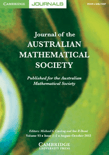
JOURNAL OF THE AUSTRALIAN MATHEMATICAL SOCIETY
Scope & Guideline
Championing excellence in mathematical research and discourse.
Introduction
Aims and Scopes
- Algebra and Group Theory:
The journal includes significant contributions to algebraic structures, particularly in group theory, semigroups, and their applications. This encompasses studies on various algebraic properties, representations, and classifications. - Geometry and Topology:
Research in this area explores geometric structures, topological properties, and their interrelations. Articles often investigate the geometric aspects of manifolds, spaces, and mappings, contributing to a deeper understanding of both classical and modern geometry. - Functional Analysis and Operator Theory:
The journal features work on functional spaces, operator algebras, and related topics. This includes studies on boundedness, compactness, and various properties of operators in different mathematical settings, particularly within Banach and Hilbert spaces. - Combinatorics and Graph Theory:
This area focuses on combinatorial structures and graph properties, examining both theoretical aspects and applications. Topics often include enumeration, graph embeddings, and algorithmic approaches. - Mathematical Physics and Applications:
The journal publishes research intersecting mathematics and physics, particularly in areas such as dynamical systems, statistical mechanics, and quantum theory. This includes the application of advanced mathematical techniques to solve physical problems. - Number Theory and Arithmetic:
Contributions in number theory explore properties of integers, divisibility, and prime distributions, often employing algebraic and analytical methods to address classical and contemporary problems. - Mathematical Logic and Foundations:
Research in this scope covers foundational aspects of mathematics, including set theory, model theory, and computability, aiming to deepen the understanding of mathematical reasoning and structure.
Trending and Emerging
- Algebraic Structures and Representation Theory:
There has been a notable increase in research concerning algebraic structures, particularly representation theory of groups and semigroups. This trend highlights the growing interest in understanding symmetries and their applications across various mathematical domains. - Geometric Analysis and Differential Geometry:
Emerging themes in geometric analysis and differential geometry have gained traction, with research focusing on curvature, flows, and geometric structures. This reflects a growing interdisciplinary approach, connecting geometry with analysis and mathematical physics. - Nonlinear PDEs and Variational Methods:
The trend towards studying nonlinear partial differential equations, particularly through variational methods, has become more prominent. This area is crucial for modeling complex phenomena in physics and engineering, indicating a shift towards applied mathematics. - Category Theory and Homotopy Theory:
An increase in research involving category theory and homotopy theory is evident, suggesting a trend towards abstract algebraic frameworks that provide unified approaches to various mathematical problems. - Computational Mathematics and Algorithms:
There is a rising interest in computational methods and algorithms, particularly in relation to mathematical modeling and simulations. This reflects the growing importance of computational techniques in solving complex mathematical problems.
Declining or Waning
- Classical Analysis:
Research focused on classical analysis, including real and complex analysis, appears to be less frequently represented in recent publications. This may indicate a shift towards more abstract or applied mathematical research. - Elementary Number Theory:
Traditional topics in elementary number theory, such as basic divisibility and congruences, have seen a decrease in publication frequency. This could suggest a trend towards more advanced or computational approaches in number theory. - Discrete Mathematics:
The representation of discrete mathematics, particularly in areas like combinatorial designs and classical graph theory, has waned. This may reflect a broader trend towards continuous mathematics and its applications.
Similar Journals
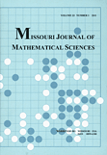
Missouri Journal of Mathematical Sciences
Fostering Ideas, Fueling Mathematical ProgressThe Missouri Journal of Mathematical Sciences, published by the CENTRAL MISSOURI STATE UNIVERSITY, DEPARTMENT OF MATHEMATICS & COMPUTER SCIENCE, serves as an essential platform for disseminating innovative research and advancements in the field of mathematics. Since its inception in 2001, this journal has provided a space for scholars, professionals, and students to exchange ideas and present their findings, contributing to the growing body of knowledge in mathematics. Despite its current category quartile ranking of Q4 in Mathematics (miscellaneous), the journal aims to enhance its impact further, encouraging contributions that push the boundaries of mathematical sciences. Although it operates without an open-access model, it is dedicated to fostering academic discourse and making a meaningful impact through its publications. Researchers interested in exploring mathematical concepts will find this journal to be a valuable resource as it continues to evolve through the years up to 2024, aiming to attract high-quality submissions that showcase significant and practical advancements in mathematics.

PROCEEDINGS OF THE INDIAN ACADEMY OF SCIENCES-MATHEMATICAL SCIENCES
Unveiling the Potential of Mathematics in a Changing WorldPROCEEDINGS OF THE INDIAN ACADEMY OF SCIENCES-MATHEMATICAL SCIENCES is a premier journal published by Springer India, dedicated to advancing the field of mathematics through the dissemination of high-quality research. With its foundation dating back to 1978, the journal serves as a pivotal platform for researchers, professionals, and students alike, fostering a vibrant academic community focused on the latest developments in mathematical sciences. Although currently positioned in the Q3 category for Mathematics (miscellaneous) with a Scopus rank of #340/399, the journal holds immense potential for growth and wider recognition within the academic sphere. It features articles that span various mathematical disciplines, encouraging innovative ideas and methodologies that contribute significantly to the field. The journal's contributions are especially relevant in the context of expanding mathematical applications in science and technology. Though it operates without an Open Access option, the journal remains an invaluable resource for anyone engaged in mathematical research, offering insights that inspire future studies and collaborations.

COLLOQUIUM MATHEMATICUM
Engaging minds with groundbreaking mathematical concepts.COLLOQUIUM MATHEMATICUM, published by ARS POLONA-RUCH, serves as an essential platform for the dissemination of innovative research in the field of mathematics. With an ISSN of 0010-1354 and a dedicated E-ISSN of 1730-6302, this journal plays a crucial role in advancing mathematical knowledge and fostering collaboration within the academic community. Although it is categorized in the Q3 quartile for miscellaneous mathematics, its content consistently attracts a diverse readership, reflecting a wide array of mathematical disciplines. Spanning publication years from 2001 to 2009 and resuming from 2011 to the present, *COLLOQUIUM MATHEMATICUM* offers researchers, professionals, and students the unique opportunity to engage with groundbreaking concepts and methodologies. With its home base in Warsaw, Poland, this journal not only contributes to the regional mathematical landscape but also impacts the broader global community. While currently not adopting an open access model, the journal remains committed to quality research, evidenced by its Scopus ranking within the general mathematics category. Engage with *COLLOQUIUM MATHEMATICUM* to be at the forefront of mathematical exploration.
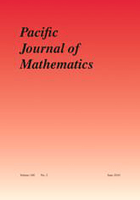
PACIFIC JOURNAL OF MATHEMATICS
Championing Excellence in Mathematical ScholarshipThe PACIFIC JOURNAL OF MATHEMATICS, established in 1951 and published by Mathematical Sciences Publishers, is a premier peer-reviewed journal in the field of mathematics, renowned for its rigorous scholarship and impactful research contributions. With an HIndex that reflects its sustained academic influence, this journal has been categorized within the Q1 quartile in the field of mathematics (miscellaneous) as of 2023, showcasing its position among the top-tier mathematics journals globally. Although the journal operates under a traditional subscription model rather than an Open Access format, it remains dedicated to disseminating original research that spans various domains within mathematics. Researchers, professionals, and students alike will find the journal's breadth of topics and commitment to quality work instrumental in advancing their understanding and exploration of mathematical concepts. This esteemed journal continues to thrive as a vital resource for the mathematical community through its comprehensive collection of articles from a diverse range of mathematical disciplines, thus maintaining a significant role in shaping the future of mathematical inquiry.

TRANSACTIONS OF THE AMERICAN MATHEMATICAL SOCIETY
Elevating the Standards of Mathematical ScholarshipTRANSACTIONS OF THE AMERICAN MATHEMATICAL SOCIETY, published by the American Mathematical Society, is a premier journal in the field of mathematics that has been contributing to the advancement of mathematical knowledge since 1900. With an ISSN of 0002-9947 and an E-ISSN of 1088-6850, this journal holds a prestigious position in the academic landscape, evidenced by its Q1 rankings in both Applied Mathematics and Miscellaneous Mathematics categories as of 2023. With a Scopus ranking of #97 in General Mathematics and a percentile standing of 75th, the journal is recognized for its rigorous peer-review process and the quality of the research it publishes. Though it does not currently offer open access options, it essentially serves as a vital resource for researchers, professionals, and students seeking critical insights and developments in mathematical theory and applications. The Transactions aim to publish high-quality research articles that foster the exchange and dissemination of ideas, supporting the growth of both theoretical and applied mathematics within the global scholarly community.
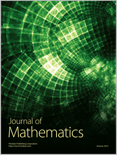
Journal of Mathematics
Advancing mathematical frontiers through open access.Welcome to the Journal of Mathematics, a premier open access journal published by Hindawi Ltd, dedicated to advancing knowledge in the diverse realm of mathematics. Since its inception in 2013, the journal has provided a platform for the dissemination of significant mathematical research and applications, achieving recognition in the 80th percentile of the general mathematics category as per Scopus rankings. With a commitment to fostering academic collaboration and accessibility, the journal promotes critical dialogue among researchers, professionals, and students alike. Located in the vibrant academic hub of London, England, the Journal of Mathematics continues to enhance its impact within the mathematical community, as evidenced by its Q3 classification in mathematics (miscellaneous) for 2023. Join us in exploring groundbreaking research and innovations, as we converge towards the future of mathematical sciences through our open access model.
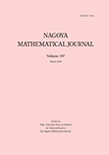
NAGOYA MATHEMATICAL JOURNAL
Connecting Scholars to Cutting-Edge Mathematical InsightsNAGOA MATHEMATICAL JOURNAL, published by Cambridge University Press, is a prestigious journal that has been at the forefront of advancing mathematical scholarship since its inception in 1950. With an ISSN of 0027-7630 and an E-ISSN of 2152-6842, this journal has gained recognition for its high-quality research contributions in the field of mathematics, achieving a Q1 classification in Mathematics (miscellaneous) as of 2023. The journal’s impact is further reflected in its Scopus rank of #164 out of 399 in the General Mathematics category, positioning it within the 59th percentile of its peers. Scholars, researchers, and students can access a range of innovative mathematical studies that explore diverse topics, fostering a vibrant dialogue within the mathematical community. By catering to a global audience, the NAGOYA MATHEMATICAL JOURNAL continues to play a critical role in shaping contemporary mathematical discourse and research.

JOURNAL OF THE AMERICAN MATHEMATICAL SOCIETY
Where Groundbreaking Theories Meet Practical ApplicationsThe Journal of the American Mathematical Society (ISSN: 0894-0347; E-ISSN: 1088-6834), published by the American Mathematical Society, stands as a pillar in the fields of mathematics and applied mathematics. This prestigious journal, with a remarkable impact factor and ranking in the top tier (*Q1*) within both the Applied Mathematics and general Mathematics categories, is recognized for its contribution to advancing mathematical research and theory. With data reflecting it as the 8th ranked journal in General Mathematics (top 2%) and the 34th in Applied Mathematics (top 6%), the journal consistently showcases groundbreaking studies and innovative methods that greatly influence academia and industry alike. Though not an open-access journal, it offers a wealth of resources and intellectual discourse for researchers, professionals, and students alike. Specializing in comprehensive and theoretical aspects of mathematics, the Journal remains dedicated to publishing articles that promote understanding and propel the field forward, highlighting its significance as an essential tool for those engaged in mathematical research.

Pure and Applied Mathematics Quarterly
Fostering Innovation in Mathematical DisciplinesPure and Applied Mathematics Quarterly is a prestigious journal published by INT PRESS BOSTON, INC, focusing on the diverse and evolving field of mathematics. Since its inception in 2007, this journal has grown significantly, currently holding a Q1 ranking in the Mathematics (Miscellaneous) category for 2023, positioning it among the leading publications in the discipline. With a commitment to publishing high-quality research, Pure and Applied Mathematics Quarterly fosters innovation and dialogue within the mathematical community by providing a platform for theoretical advancements and practical applications. The journal remains accessible to researchers and professionals through its ISSN 1558-8599 and E-ISSN 1558-8602, although it does not currently offer open access. As a vital resource for mathematicians, educators, and students, this journal endeavors to expand the frontiers of mathematical knowledge and contribute to the academic dialogue surrounding this fundamental science.
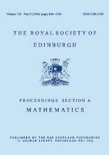
PROCEEDINGS OF THE ROYAL SOCIETY OF EDINBURGH SECTION A-MATHEMATICS
Where Innovative Theories Meet Rigorous ResearchPROCEEDINGS OF THE ROYAL SOCIETY OF EDINBURGH SECTION A-MATHEMATICS is a prestigious journal published by Cambridge University Press, focusing on high-quality research in the field of mathematics. Established in 1975, this journal has carved a niche in the academic community, evidenced by its categorization in the Q1 quartile for Mathematics (miscellaneous) in 2023 and a commendable Scopus rank of #59 out of 399 in General Mathematics, positioning it within the 85th percentile among its peers. The journal serves as a platform for disseminating innovative mathematical theories and methodologies, making it an essential resource for researchers, professionals, and students alike. Though not currently an open-access publication, it offers various access options catering to a broad audience. With a publication timeline extending through to 2024, PROCEEDINGS OF THE ROYAL SOCIETY OF EDINBURGH SECTION A-MATHEMATICS remains committed to advancing mathematical knowledge and fostering a scholarly environment conducive to scientific inquiry and collaboration.